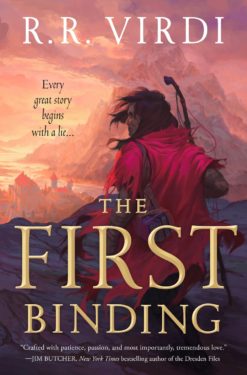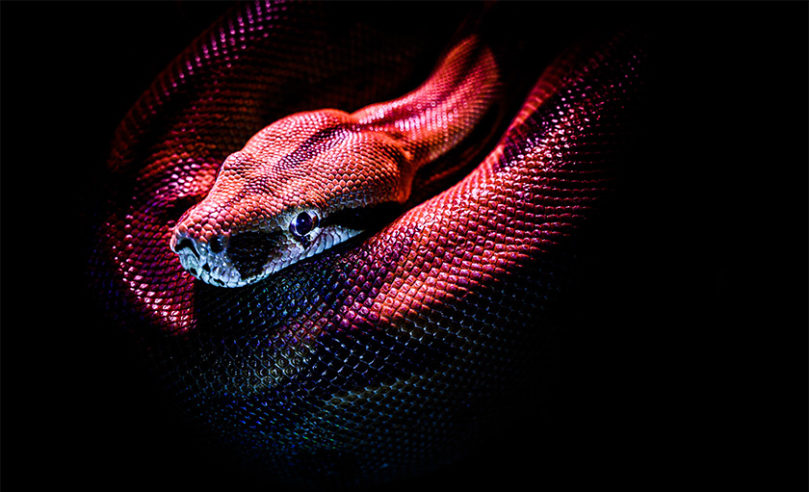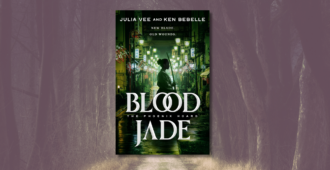 The First Binding by R.R. Virdi is the hugely epic opener to the Tales of Tremaine series, and now it’s available in paperback! A while back, Virdi wrote a thoughtful article on whether snakes are dragons as a feature for Dragon Week 4: Dragons 4Ever, and we’re bringing that back, because this is hard-hitting, important fantasy fiction analysis.
The First Binding by R.R. Virdi is the hugely epic opener to the Tales of Tremaine series, and now it’s available in paperback! A while back, Virdi wrote a thoughtful article on whether snakes are dragons as a feature for Dragon Week 4: Dragons 4Ever, and we’re bringing that back, because this is hard-hitting, important fantasy fiction analysis.
By R.R. Virdi
Are snakes dragons?
It sounds like an easy question. A rather straightforward yes or no. Snakes are snakes. Dragons are dragons.
Right?
Well…
About that.
Let’s look at what makes a dragon, well, a dragon? If you take a look at the most famous common kind, the European dragon, they’ve got pretty similar appearances throughout western mythos. And it makes sense. They’re a culmination of things humanity feared long ago all morphed into one creature.
They have the necks and facial appearances of giant serpents, armored scales, horizontally slit pupils with molten gold eyes the color of greed and avarice. Sharp teeth, and they breathe fire, something we’ve long been fascinated with, and is also terrifyingly destructive. The wings of a bat, and claws as sharp and curved as lions’. They’re the ultimate monster, most of the time. And maybe that’s where we should take our look of dragons.
What makes a monster? What are their roles in stories?
Historically speaking, they’re obstacles. They’re the big the hero has to face off and defeat to accomplish some goal, be it rescuing the princess, or in some myths, freeing a much needed river from a serpent blocking it.
Many serpents in mythology have been likened to dragons, and certainly so when we head eastwards to the Asiatic dragons. One such serpent, dragon, or obstacle, if you will, is Vritra—the headed dragon-serpent of Vedic mythology. This serpent demon held the waters of the world held hostage and blocked by its body and greed until Indra, the Vedic god of storms, sky, lightning, and rains, battled the three-headed serpent. In the end, Indra was victorious and killed the demon-snake with a club imbued with the properties of a thunderbolt. There’s another similar battle between a great worldly serpent in the waters being bested by another storm god using a weapon holding all the powers of thunder in its head.
But for this deed, Indra was gifted a new name. A name that meant two things: Slayer of Vritra, and slayer of First Born Dragons.
Vritra, the three-headed serpent, was accounted a dragon then and there. When you go back far enough in mythology, the oldest of dragons in many cultures were closer to serpents than the winged beasts we often think of. And many fictional story worlds follow this convention too. In the world of Middle Earth, Glaurung, was the father of dragons.
But this beast was closer to a worm or serpent with legs than what his later descendants would come to be. Creatures such as Ancalagon the Black, the greatest and largest of all dragons to ever be birthed in Middle Earth. A winged monster so great he dwarfed mountains.
Regardless of their shape, though, all dragons/snakes served similar purposes in mythology: obstacles.
So I guess the question of whether snakes/serpents are dragons really does come down to, do they act as dragons? Do they serve the same purpose in the story?
In the Epic of Beowulf, the “dragon” is often also described as a serpent, or a worm. And while some instances mention the fire breathing aspects, some also mention the venomous bite. All throughout stories, serpents have been often interchangeable with dragons, which might be evidence in and of itself that they are the same things. Or, at least, that dragons comes from serpents, if that weren’t already obvious in their appearance.
A dragon in a story historically is the antagonist. Is that always true, especially today? No. But for their history, they were something to be defeated. Not for the sake of doing so, but they were already in a place of opposition to the needs of innocent people. They were hoarding needed wealth, demanding human sacrifices, or keeping natural resources from the populace.
In the FromSoftware game, Sekiro, a dragon comes to their land from off far away and throws off the natural process of life and death, allowing for something close to immortality and rebirth for a select few…
All at the cost of perverting the balance of things and spreading a disease known as dragonrot. The world is festering with it and people suffer. This dragon resembles the Asiatic design of dragons, closer to serpents than the European counterparts. But before you ever get to fight this great beast, you must navigate a frozen valley guarded by a monstrous white serpent closer to a giant viper than a dragon. But it may as well be a dragon, because at this point in the story, it is most certainly an obstacle.
One you’re not equipped to defeat. Only to survive.
But until that point in the game, you are only to evade this monstrous serpent that blocks your path, and do your best to come back at a later time to claim its heart. But if you dig into the lore of this creature, you’ll realize it serves another similar role to dragons. This serpent claimed sacrifices. There is a little tent in where offerings of people were left for the beast to claim. There are hidden stories you can piece together letting you know people offered members of their clans or villages up to these giant white serpents.
Sounds very similar to dragons.
Maybe, like many things throughout history, dragons have just changed shape, and their names. Nothing more.
As time’s gone on, and more media continues to birth new stories, we’ve come to classify all kinds of dragons with new names: wyrms, wyverns, drakes, amphitheres, lindworms, and so on. But the truth remains: they were serpents first, and I suppose, they’re serpents still.
So long as they exist to be something standing in the way of your protagonists, they’re all dragons, and when we have existing series where dragon can even be a mantle, or a title, that any old vanilla mortal can claim, well, I guess dragons really as mutable as the fires they breathe.
Perhaps the real dragons are the snakes…we met along the way?
Is that giant three-hundred foot long serpent blocking your mountain pass? Well, that’s a dragon. That fire breathing wingless, legless, snake that’s burning your favorite kebab place down? That, my friends, is a dragon.
That jerkwad who cut you off in his dinged up 1990’s Toyota Previa (that should have long fallen apart due to the tolls of time, never mind his accidents) with his peeling Whitesnake decals all over his doors?
Yeah, I suppose that’s a dragon too.
I guess the takeaway is: all obstacles can be dragons, but not all snakes are dragons? But some snakes are dragons, so long as they’re obstacles. But not all obstacles are snakes.
See, it’s easy!
So, are snakes dragons? I guess…it depends.
But they can be, and that’s the pretty nifty thing about fantasy. Anything can be a dragon if you work hard enough to make it so.
Note for all the danger noodle owners in the world: yes, your sweet little reptiles can also be dragons – the bestest of dragons.
R.R. Virdi is a two-time Dragon Award finalist, Nebula Award finalist, and USA Today Bestselling author. He is the author of two urban fantasy series, The Grave Report and The Books of Winter, as well as the epic fantasy novel The First Binding. His love of classic cars drove him to work in the automotive industry for many years before he realized he’d do a better job of maintaining his passion if he stayed away from customers.
He was born and raised in Northern Virginia and is a first generation Indian-American with all the baggage that comes with. He’s offended a long list of incalculable ancestors by choosing to drop out of college and not pursue one of three pre-destined careers: a lawyer, doctor, engineer. Instead, he decided to chase his dream of being an author. His family is still coping with this decision a decade later. He expects them to come around in another fifteen to twenty years.
Order The First Binding in Paperback Here












Comments are closed.
Leave a Reply